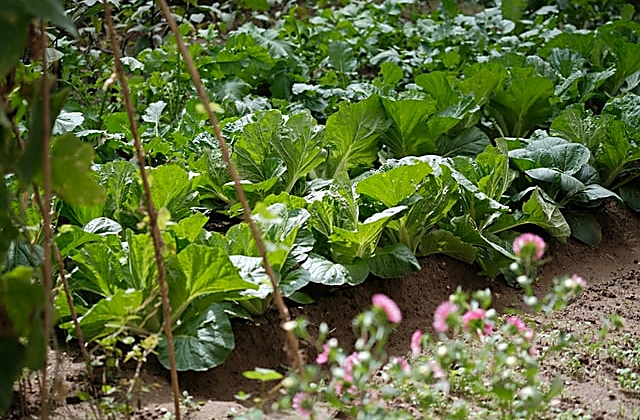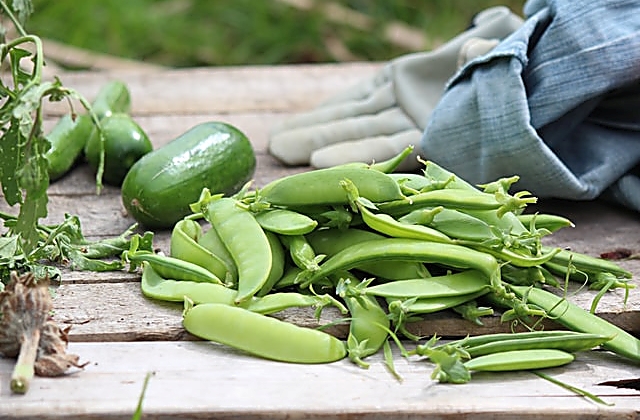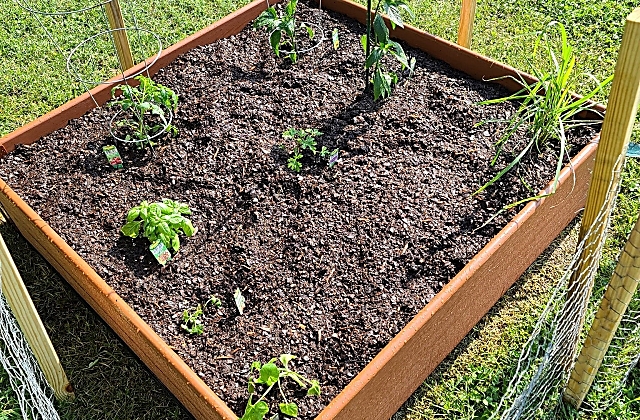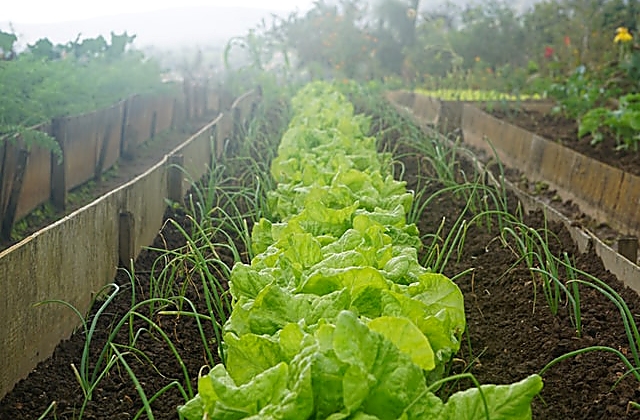Grow Your Own: Starting a Vegetable Garden Today

Imagine biting into a juicy tomato or crunchy carrot, freshly harvested from your own backyard or patio. Growing a vegetable garden is rewarding and connects you with nature. It lets you enjoy the best-tasting produce right from your own space. Whether you have a big yard or a small balcony, starting a garden is easier than you think.
This guide will help you plan, plant, and maintain a thriving vegetable garden. Vegetable gardening has many benefits. It cuts down on carbon emissions from transporting produce. It’s great for exercise, stress relief, and teaching kids about nature. Plus, there’s nothing better than eating your own homegrown veggies and herbs.
Key Takeaways
- Growing your own vegetables is a rewarding and sustainable way to enjoy fresh, flavorful produce.
- Vegetable gardening offers benefits such as reducing your environmental impact, providing exercise, and teaching children about nature.
- With proper planning and preparation, even beginner gardeners can successfully start a thriving vegetable garden.
- Choosing the right location, preparing the soil, and selecting the right vegetables for your climate are key to a successful garden.
- Ongoing maintenance, including watering, fertilizing, and pest control, is essential for a bountiful harvest.
Why Start a Vegetable Garden?
Growing your own vegetables is great for many reasons. It helps you live a sustainable life and cuts down on your carbon footprint. Since you grow your own food, you use less transportation and packaging. This means less harm to the environment.
Homegrown veggies taste better and are more nutritious than store-bought ones. Gardening also makes you eat healthier and can save you money. Plus, it’s a rewarding hobby that lets you connect with nature.
Benefits of Growing Your Own Produce
- Reduced carbon footprint by minimizing transportation and packaging
- Fresher, more flavorful, and more nutritious vegetables
- Potential cost savings on grocery bills
- Promotion of healthier eating habits
Connecting with Nature and Sustainable Living
Growing your own veggies is a way to connect with nature and live sustainably. It lets you feel the cycles of life and nature’s rhythms. This connection is fulfilling and helps you appreciate the environment more.
By gardening, you’re moving towards a sustainable future. You’re reducing your environmental impact and living healthier. The benefits of gardening go beyond your garden, helping you and the planet.
Choosing the Right Location
Finding the perfect spot for your vegetable garden is key to its success. It should offer the best growing conditions for your plants. Think about these important factors when picking the right garden spot:
Sun Exposure
Most vegetables need 6-8 hours of direct sunlight daily. Ideally, they love 8-10 hours of sun. Look at your yard’s sun patterns. Pick a spot that gets plenty of sunlight all day.
Soil Quality and Drainage
Soil that drains well and is full of nutrients is vital for healthy veggies. Stay away from places that get too wet or have poor drainage. This can cause root rot and other problems. Before planting, add compost or other organic stuff to the soil.
Wind Protection
Strong winds can hurt your plants. So, pick a spot that’s safe from the wind. Think about putting your garden near a fence, hedge, or building. These can act as a natural windbreak.
By looking at these factors, you can find the best spot for your vegetable garden. This way, your plants will get enough sunlight, good soil, and protection to grow well.
“The right location can make all the difference in the success of your vegetable garden.”
Preparing the Soil
Starting a vegetable garden begins with preparing the soil. This step is key for your plants to grow well and give you lots of food. Let’s look at how to get your soil ready for your garden.
Soil Testing and pH Adjustment
First, test your soil’s pH level. Most vegetables like soil that’s a bit acidic to neutral, between 6.0 and 7.2 pH. If your soil is too acidic or alkaline, you can fix it by adding lime or sulfur.
Loosening and Aerating the Soil
Use a spade or garden fork to loosen and aerate the soil. This makes it better for drainage and root growth. Make sure to remove weeds, rocks, and debris while you’re at it.
Incorporating Organic Matter
Adding organic stuff like compost, manure, or leaf mold changes the game for your garden. These materials make the soil better at holding water and nutrients. Try to mix in a 2-3 inch layer of this stuff before planting.
By doing these steps, you’ll make your soil perfect for your vegetable plants. With great soil, you’re on your way to a garden full of life and plenty of food.
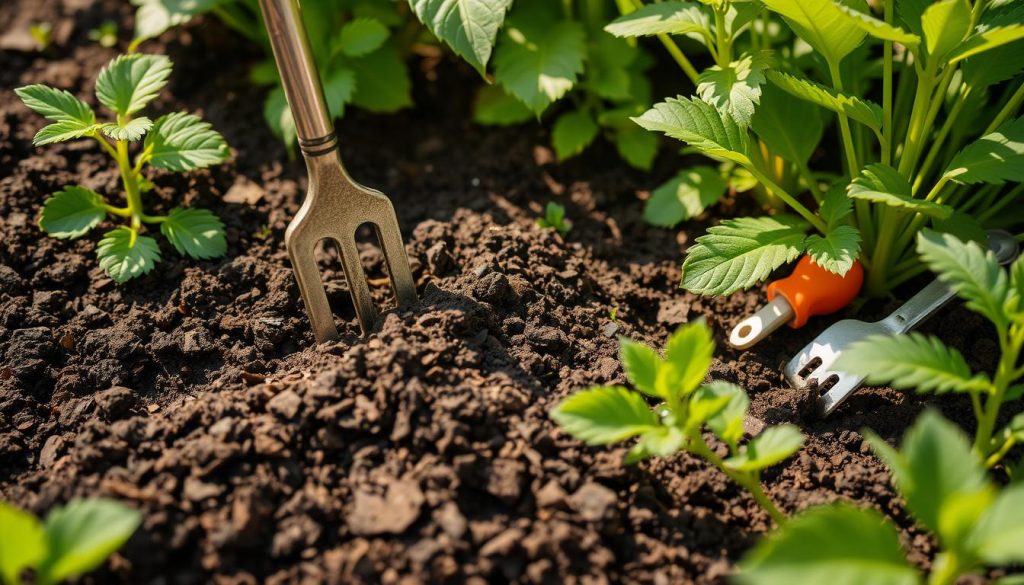
“Healthy soil is the foundation for a successful vegetable garden. Take the time to properly prepare and amend your soil, and you’ll be rewarded with lush, productive plants.”
Selecting Vegetables to Grow
Starting a vegetable garden means picking easy-to-grow veggies that fit your local climate and season. Top picks for beginners include lettuce, green beans, radishes, tomatoes, zucchini, peppers, beets, carrots, chard, spinach, kale, and peas. These easy vegetables to grow are tough, yield well, and need less care than harder crops.
Choosing Varieties Based on Climate and Growing Season
Think about your local climate and season when picking veggies. Cool-season vegetables like lettuce and broccoli do well in cool early spring and fall. Warm-season crops like tomatoes and peppers love the heat of late spring and summer. For a short season, choose fast-growing varieties that mature before frost. Check with your local Cooperative Extension Service for the best climate-appropriate vegetables and vegetable varieties for your area.
| Vegetable | Growing Season | Climate |
|---|---|---|
| Lettuce | Cool-season | Cold-weather crops |
| Tomatoes | Warm-season | Warm-weather crops |
| Carrots | Cool-season | Cold-weather crops |
| Zucchini | Warm-season | Warm-weather crops |
“When selecting vegetables to grow, it’s crucial to choose varieties that you and your family will actually enjoy eating.”
Planning Your Vegetable Garden Layout
Creating the perfect vegetable garden layout is key to a successful garden. Think about plant height, growth habits, and sunlight needs to use your space well. Companion planting is a great way to keep pests away, help with pollination, and get more nutrients.
Make sure your garden gets at least 8 hours of sunlight each day. Keep your beds 3-4 feet wide for easy reach and to avoid compacting the soil. Put plants with the same sunlight needs together. Place taller plants on the north side to not block the sunlight from the smaller ones.
Companion Planting and Garden Design
Companion planting makes your garden work better together. Plant herbs like marigolds and nasturtiums with your veggies to keep pests away. Add flowers that attract good insects to eat the bad ones. Also, having a compost bin or heap makes soil better for your plants.
- Group plants with similar sunlight, water, and nutrient needs
- Position taller crops on the north side to avoid shading shorter plants
- Use vertical space with trellises or cages for climbing vegetables
- Include pathways for easy access for upkeep and picking
- Try raised beds or containers for a neat, space-saving garden
Plan your vegetable garden well to make it a place that grows lots of food year after year. A bit of planning makes your garden more productive and pretty.
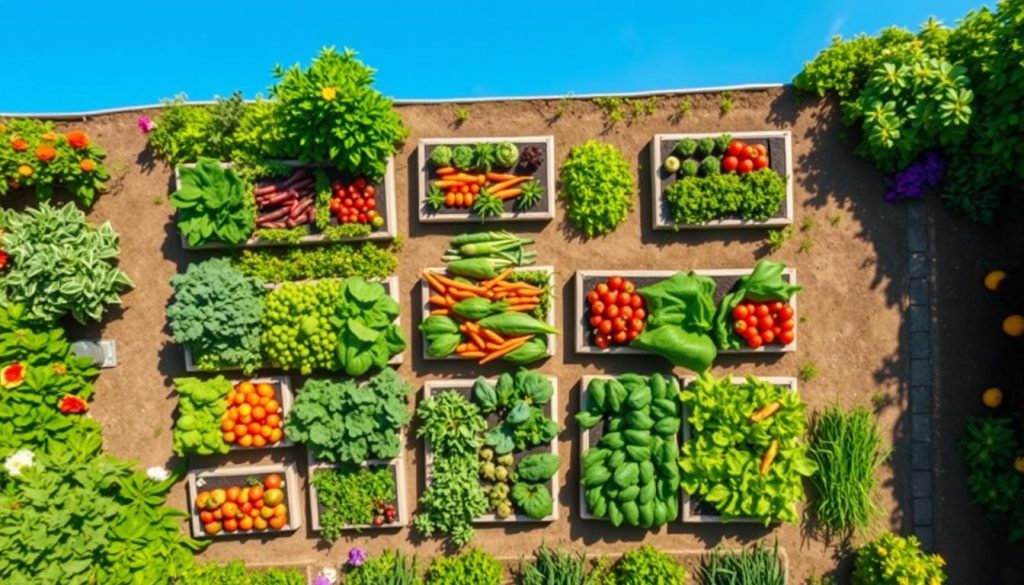
Sowing Seeds and Planting
Starting a vegetable garden can be done by sowing seeds directly or by transplanting seedlings. Each method has its own benefits. The best choice depends on the crop and the growing conditions.
Direct Sowing vs. Transplanting Seedlings
Direct sowing is a budget-friendly way to begin gardening. It cuts out the need for nursery plants. Carrots, beans, and radishes do well when sown directly. They don’t like being moved after planting.
However, transplanting seedlings indoors is better for plants like tomatoes and peppers. These plants are sensitive to temperature changes. This method lets gardeners create the best conditions for young plants before they go outside.
| Method | Advantages | Suitable Crops |
|---|---|---|
| Direct Sowing |
|
|
| Transplanting Seedlings |
|
|
It’s important to follow the instructions on seed packets or plant tags for planting depth and spacing. With attention and some experimentation, gardeners can discover the best method for their sowing seeds, seed starting, and transplanting seedlings.
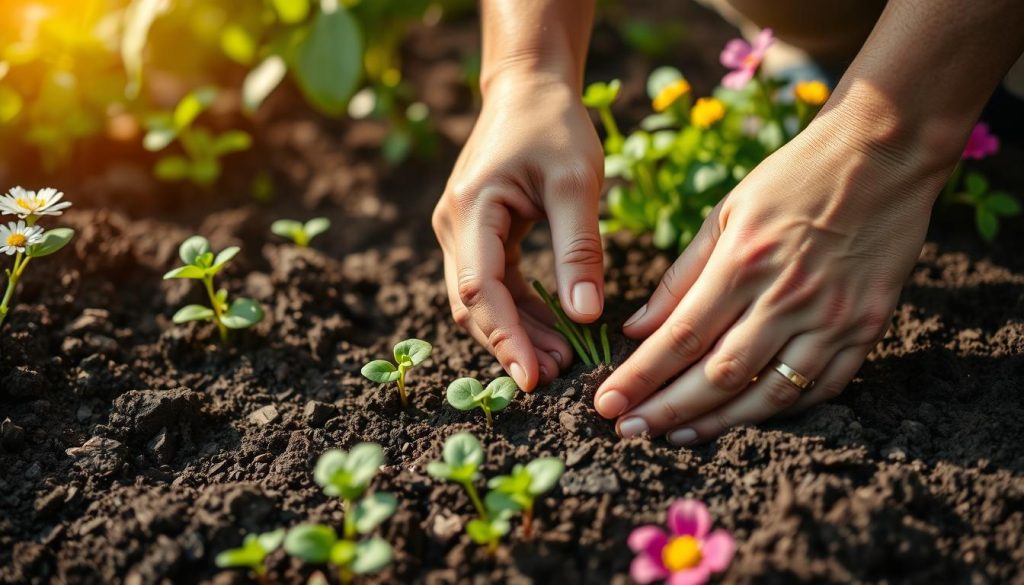
Watering and Irrigation
Proper watering is key for your vegetable garden‘s health and growth. Most veggies need about 1 inch of water each week, from rain or irrigation. In hot, dry weather, you might need to water more often to keep plants healthy.
Efficient Watering Techniques for Hot Weather
When it’s hot, focus on watering your garden wisely. Water in the late afternoon or early evening to cut down on evaporation. Using soaker hoses or drip irrigation systems saves water and gets it right to the roots. You can also make furrows and basins to slowly soak water into the soil.
If your garden has sandy soil, you might need to water twice a week. But if it’s heavy clay or rich in organic matter, once a week might be enough. Mulching helps keep the soil moist and cuts down on watering.
Keep an eye on the soil moisture and adjust your watering as needed. Dig a little to check if the soil is moist. If plants start to wilt or show signs of heat stress, water them right away. They need enough water conservation to grow well.
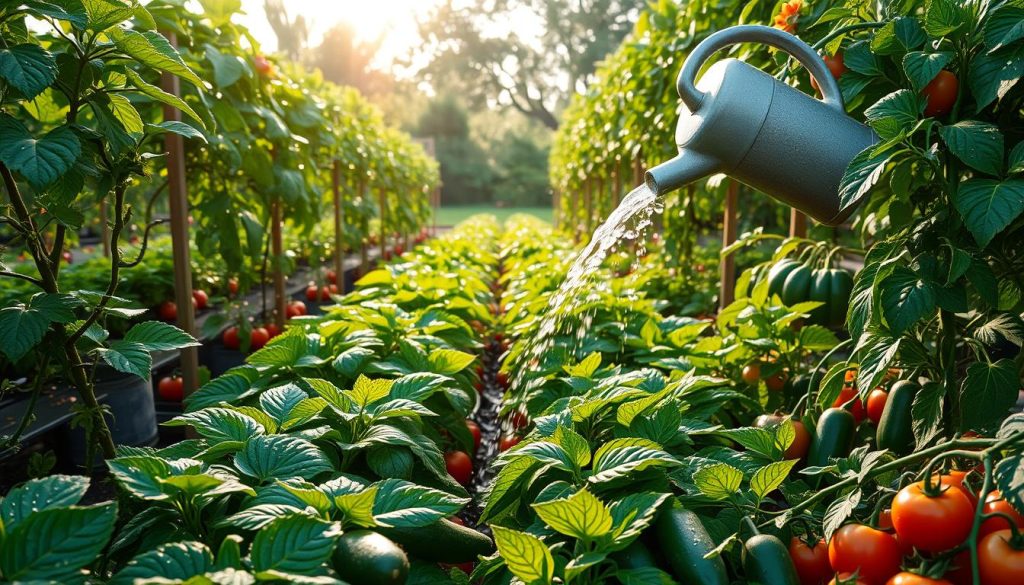
“Efficient watering is the key to a thriving vegetable garden during hot weather.”
Fertilizing and Nutrient Management
Keeping the right amount of nutrients in the soil is key for a healthy vegetable garden. You can use organic fertilizers like compost, manure, or fish emulsion, or synthetic fertilizers. Always follow the instructions on the fertilizer package and don’t overdo it, as it can harm your plants. Adding organic matter like compost helps improve soil fertility and structure over time. This way, your vegetables will get what they need to grow well.
Each type of plant needs different nutrients. Leafy greens need more nitrogen than beans and peas. For vegetable crops, a general rule is to use 2 lbs. of nitrogen per 1,000 square feet. But, some plants need more, like 3 lbs. per 1,000 square feet.
High nitrogen organic fertilizers include cottonseed meal, nitrate of soda, and others. These help your plants grow strong.
Adding organic matter to the soil can release about 0.4 lbs. of nitrogen per 1,000 square feet. For a typical vegetable garden, you should aim for about 2 lbs. of nitrogen per 1,000 square feet. This matches a 5% organic matter level in the soil. There are many ways to apply fertilizers, like broadcasting, banding, and foliar methods.
It’s crucial to keep the soil’s pH level right for nutrients to be available to your plants. Most vegetable crops do best in soils with a pH of 6.5-6.8. If your soil is too acidic, you can use lime or wood ash to fix it. These also add calcium and magnesium.
Synthetic fertilizers should be used at a rate of 25 lbs/1000 sq. ft. of 10-10-10. For organic fertilizers, use about 60 lbs/1000 sq. ft. of 4-3-3. Proper nutrient management is key to helping your vegetables grow well.
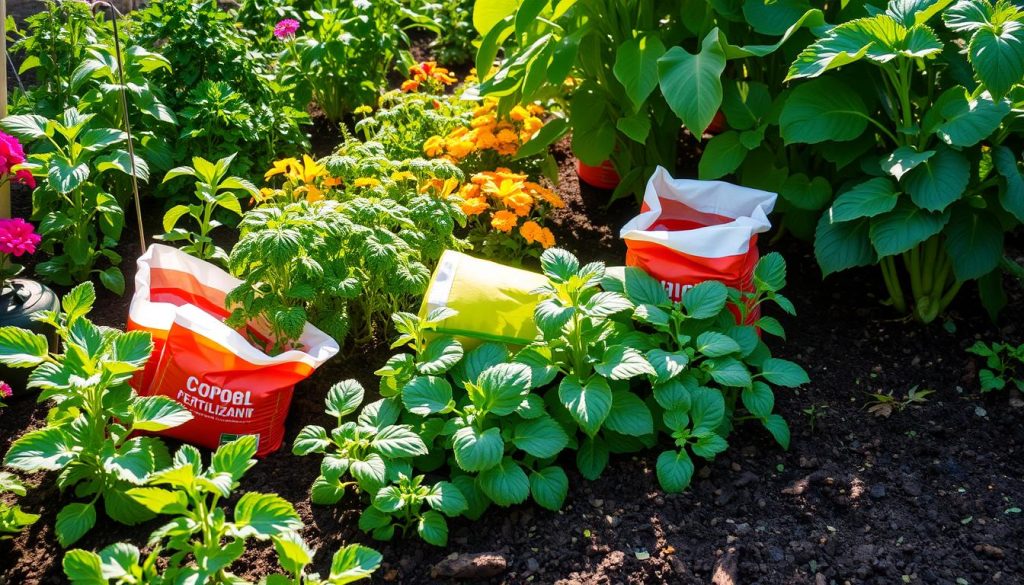
Pest and Disease Control
Keeping a vegetable garden healthy means watching out for pests and diseases. Luckily, there are many ways to fight off pests without using harsh chemicals. You can use organic pest control and natural pest management methods to protect your garden.
Organic and Natural Methods
Start by using companion planting in your garden. Some plants, like marigolds, keep pests away and bring in good bugs. Row covers and barriers can also stop birds, rabbits, and other animals from getting to your plants.
For fighting pests, try eco-friendly products like neem oil, diatomaceous earth, or insecticidal soaps. These natural options can control aphids, slugs, and other pests without hurting the planet. Handpicking pests like Japanese beetles can also work well.
To prevent diseases, focus on keeping your garden clean. Remove any sick plants right away, rotate your crops, and pick plants that resist disease. Using drip irrigation can also help by keeping leaves dry and lowering the chance of fungal diseases.
By using organic and natural pest control methods, you can grow a healthy, productive vegetable garden. With a bit of effort, you can keep your garden safe and full of food without harming the environment.
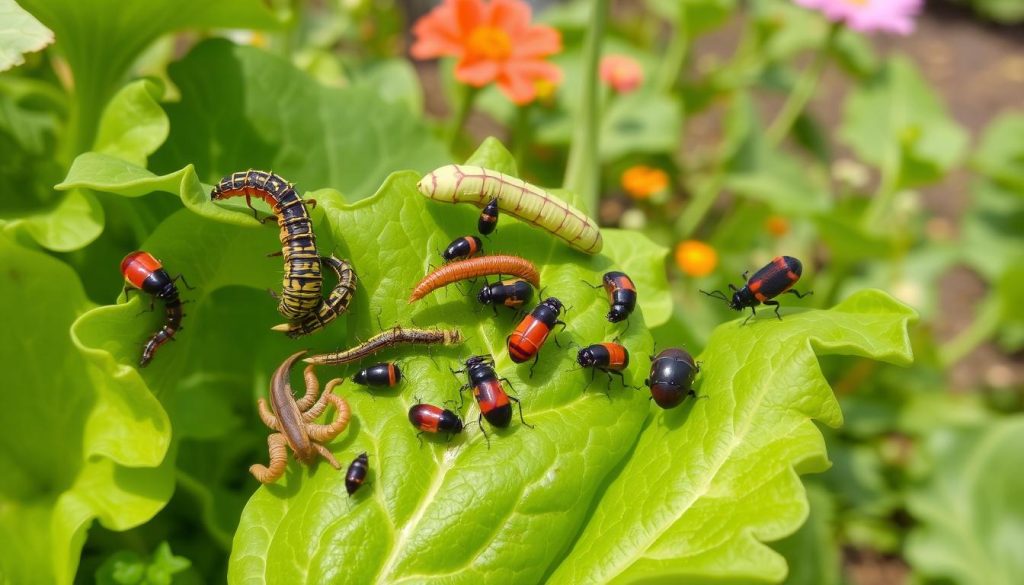
Vegetable Garden Maintenance
Keeping a vegetable garden healthy takes regular care. Tasks like pruning, weeding, and replacing old plants are key. They help you get a good harvest all season.
Pruning for Optimal Growth
Vegetable garden maintenance means pruning often. Cutting back overgrown plants helps them grow better and produce more. It stops plants from crowding each other, letting sunlight and air in.
Weeding for Nutrient-Rich Soil
Weeding is a big part of vegetable garden care. Pulling weeds stops them from taking nutrients and space from your plants. This keeps your garden clean and ready for more growth.
Replacing Plants for Continuous Productivity
Some plants in your garden may not last the whole season or produce as much. Replacing plants keeps your garden fresh and full of food. It brings in new, healthy plants for a steady harvest.
| Maintenance Task | Frequency | Benefits |
|---|---|---|
| Pruning | Weekly or as needed | Promotes growth, prevents overcrowding, improves fruit/vegetable production |
| Weeding | Weekly or as needed | Removes competition for nutrients and space, allows desired plants to thrive |
| Plant Replacement | As needed | Maintains continuous productivity and a thriving vegetable garden |
By focusing on these key vegetable garden maintenance tasks, your garden will stay healthy and full of food. This way, you’re always ready for a great harvest.
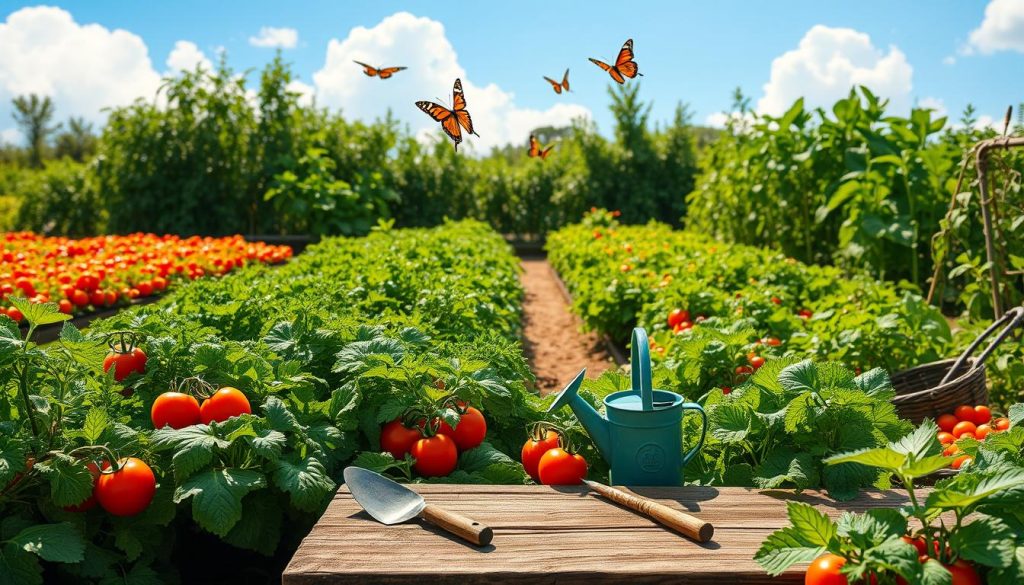
Harvesting Your Vegetables
Harvesting your vegetables right is key to getting the best flavor, texture, and nutrients. Keep an eye on your crops and pick them when they’re fully ripe. This ensures you get the most out of your garden.
Each vegetable has its own way of being harvested. Some, like leafy greens, should be picked often to keep them coming. Others, like tomatoes and melons, need to ripen on the plant. Picking at the right time makes a big difference in taste and quality.
When you harvest, be gentle. Use methods like cutting or twisting to avoid hurting the plant. This keeps your plants healthy and helps you maximize yields all season.
After picking, think about how to store or preserve your vegetables. Options include canning, freezing, or drying. This way, you can enjoy your harvest all year and extend the shelf life of your vegetables.
Harvesting Techniques for Common Vegetables
- Asparagus: Harvest spears when they reach 6 to 8 inches in height, avoiding adjacent spears.
- Beans: Harvest pods when they are pencil-thick and snap easily, avoiding very slender or bulging pods.
- Beets: Pull beets when they are approximately 1½ to 2½ inches in diameter for optimal flavor.
- Broccoli: Harvest heads when they are 3 to 6 inches in diameter with tightly closed buds.
- Carrots: Harvest when they reach ¾ to 1-inch diameter, and store for 4 to 6 months at 33°F with high humidity.
| Vegetable | Ideal Harvesting Time | Storage Duration |
|---|---|---|
| Cabbage | When heads are firm and fully developed | Up to 1 month in the refrigerator |
| Cantaloupe | When the fruit separates easily from the stem | Up to 10 days in the refrigerator |
| Sweet Corn | When the husk is green, and the silks are dry and brown | Should be consumed shortly after harvesting for optimal sweetness |
Using the right vegetable harvesting techniques and storage is key. It helps you maximize yields and enjoy your garden all year.
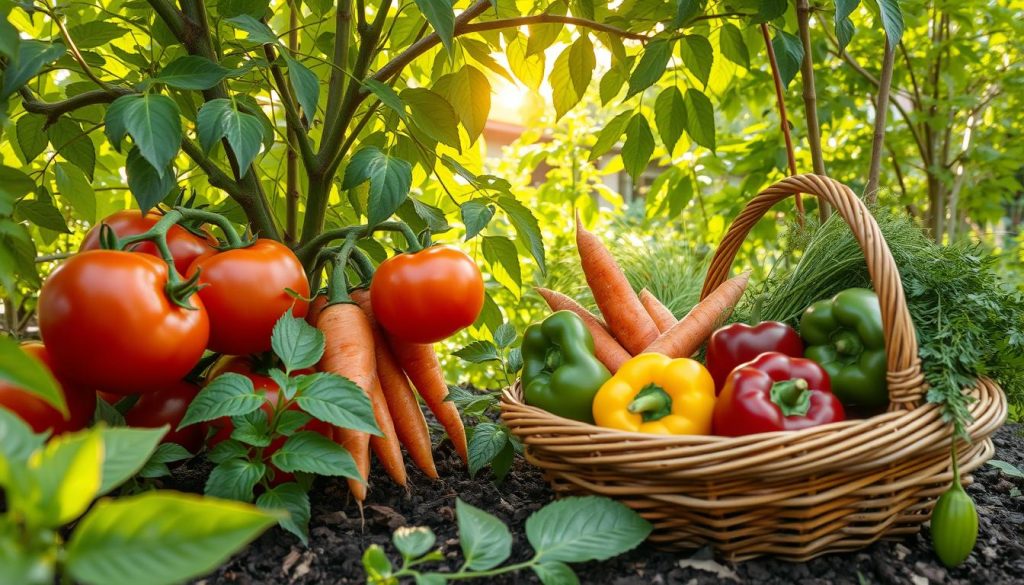
Container Gardening for Small Spaces
If you have a small yard, patio, or balcony, container gardening is a great way to grow your own veggies. This method lets you garden even in tight spots in cities or suburbs.
Tips for Growing Vegetables in Containers
Here are some tips to start with container gardening:
- Use containers like 5-gallon buckets or raised boxes and fill them with good potting mix.
- Pick small vegetable types that do well in small spaces, like cherry tomatoes, bush beans, or lettuce.
- Make sure your containers drain well to avoid waterlogging and keep your plants healthy with regular watering.
- Think about the sunlight and temperature your plants need to give them the best conditions.
- Feed your plants with organic fertilizer or compost often to give them the nutrients they need.
With the right containers and plants, you can have a big harvest in a small space. Container gardening is perfect for beginners because it’s easier and cheaper than traditional gardens. It also lets you enjoy fresh veggies and the happiness that comes from gardening.
| Garden Type | Container Size | Recommended Plants |
|---|---|---|
| Salsa Garden | 20 gallons (91 L) | 1 garlic, 1 plum or paste tomato, 1 pepper, 6 green onions, 4 cilantro |
| Cocktail Garden | 2 gallons (9 L) | Lemon tree, various herbs, strawberries |
| Windowsill Herb Garden | 2 gallons (9 L) | Green onions, purple basil, green basil, parsley, oregano |
| Tomato Sauce Garden | 20 gallons (91 L) | Garlic, plum tomatoes, oregano, basil, parsley |
| Kids Garden | 10 gallons (45 L) | Strawberries |
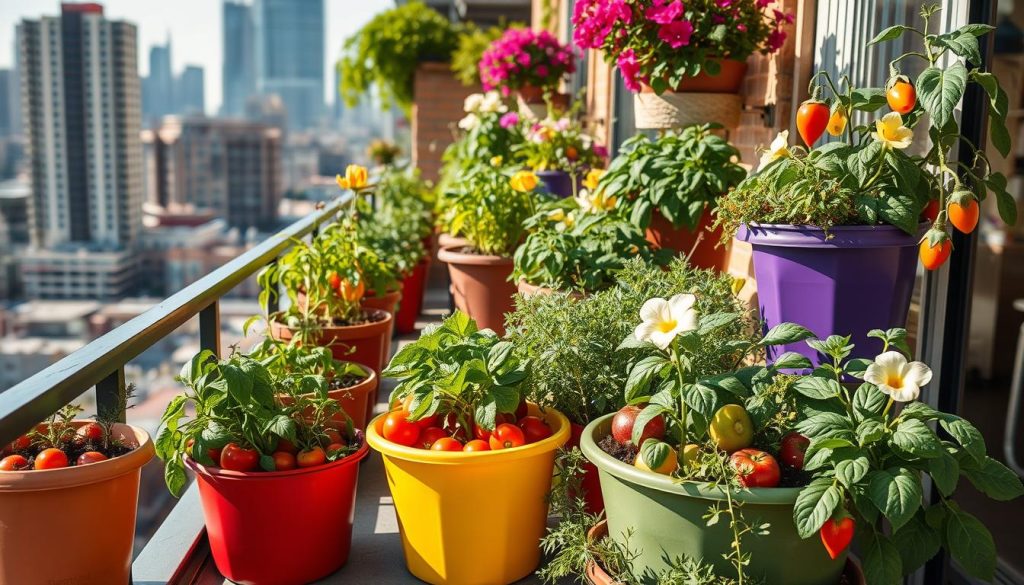
“In 2010, on a northwest-facing balcony in London, south-facing windowsills, and a growing ladder, it was possible to grow 83.4kg (184lb) of food, valued at approximately £899 within a year.”
This shows how well container gardening can work in small urban areas. By picking the right containers and plants, you can grow a garden that gives you a lot of fresh veggies.
Gardening Tools and Supplies
Having the right gardening tools and supplies makes starting and keeping a vegetable garden easier and more fun. You’ll need tools like shovels and hoes, as well as special equipment. The right garden equipment can change how you garden.
For preparing the soil, a strong spade or shovel is key. A garden hoe is great for weeding and working the soil. Hand trowels and cultivators are perfect for planting and moving seedlings. Don’t forget pruning shears to keep your plants looking great.
Getting your plants the right amount of water is key, and tools like watering cans or hoses help with that. For easy transport of soil, compost, or veggies, consider a garden cart or wheelbarrow.
Depending on your garden, you might also need specialty items like grow lights, seed starting trays, or a drip irrigation system. These landscaping tools and horticultural tools can help your plants grow better.
The right gardening accessories can really change your gardening. Good tools and supplies make gardening easier and make growing your own food a better experience.
“The right tools make all the difference in the garden. Invest in quality equipment, and you’ll reap the benefits of a thriving, bountiful vegetable garden.”
Essential Gardening Tools
- Spade or Shovel
- Garden Hoe
- Hand Trowel
- Pruning Shears
- Watering Can or Hose
Specialty Gardening Supplies
- Grow Lights
- Seed Starting Trays
- Drip Irrigation System
- Garden Cart or Wheelbarrow
With the right gardening tools and supplies, you’re set to grow a great vegetable garden. You’ll enjoy a big harvest and a rewarding gardening experience.
Conclusion
Starting a vegetable garden is rewarding and fulfilling. It brings many benefits, like enjoying fresh, tasty homegrown food. It also helps you connect with nature and live more sustainably.
This guide shows you how to pick the best spot and prepare the soil. It also helps with choosing the right vegetables and keeping your garden healthy. Anyone can grow a successful vegetable garden, even in small spaces. Watching your plants grow and picking your own food is a special joy.
Growing vegetables is more than just getting food. It connects you with nature, cuts down on carbon emissions, and is good for your mental health. Start small, try different plants, and grow your garden over time. Discover the happiness of growing your own food.
